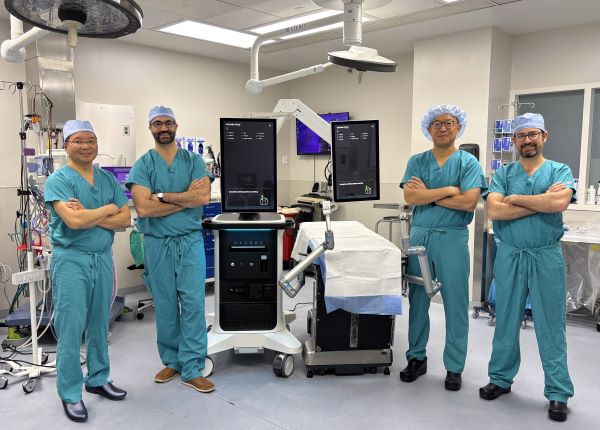Saint Mary’s Hospital the First in New England to Offer the HYDROS™ Robotic System for Treating Enlarged Prostates
March 17, 2025Waterbury, Conn. Saint Mary’s Hospital is pleased to announce that it is the first in New England to offer Aquablation® therapy with the new HYDROS™ Robotic System, the next-generation platform to treat men suffering from benign prostatic hyperplasia (BPH), or an enlarged prostate. The minimally invasive procedure offers new hope for patients experiencing the symptoms of BPH, including frequent urination, incomplete bladder emptying, and nighttime urgency. Aquablation therapy, now delivered by an AI-powered robotic system, is clinically proven to provide significant, durable BPH symptom relief while preserving sexual function and continence across prostates of all shapes and sizes.

Next-Generation AI-powered platform for Aquablation® Therapy uses the latest technology to treat Benign Prostatic Hyperplasia (BPH).
Joe, a 69-year-old Air Force veteran and recent patient at Saint Mary’s Hospital, shared his experience with the groundbreaking technology. “First off, I really admire Dr. D’Amato. Great doctor and very personable, followed up – from pre-surgery and post-surgery, ensuring all was going fine,” Joe said. “He did indicate that the robot had fewer side effects than the other procedures, but I guess it depends on what your diagnosis is.” Joe had suffered from frequent urges to urinate and, unknowingly, had an enlarged prostate. Over time, his condition worsened, leading to a severe bladder expansion that eventually caused a bowel obstruction. After experiencing excruciating pain, he landed in the emergency department, where doctors warned of potential permanent kidney damage. Given the severity of his condition, he chose Aquablation therapy and saw an improvement within a week. “I wasn’t frequently going to the bathroom and was able to void my bladder better,” he said. “I had the surgery on a Friday, was discharged on Saturday, and by Sunday, I was out snow blowing.”
“Being the first hospital in New England to offer this service displays our commitment to investing in the latest technology,” said Husnain Kermalli, M.D., Chief Medical Officer, Saint Mary’s Hospital. “Not only that, but it also helps ensure the best outcomes for our patients, keeping them at the center of all we do.”
BPH is an unfortunate reality of aging for millions of men and impacts urinary function, making it difficult to urinate and fully empty the bladder. Without timely treatment, BPH can lead to severe health issues such as permanent bladder or kidney damage, bladder stones, and incontinence. One in two men ages 51-60 have BPH, and 99 percent of men say BPH impacts their quality of life. The standard treatment option today is surgery, but this has been shown to impact sexual function and continence.
“BPH is a widespread condition that severely compromises quality of life for countless men over age 50. With Aquablation therapy, men can reclaim their lifestyles and find relief from symptoms while preserving sexual function and continence -- outcomes that have proven elusive with many traditional treatment modalities,” said York Paul Moy, M.D., Medical Director of Men’s Health Institute and Chief of Urology, Trinity Health Of New England. Aquablation therapy was designed to offer a minimally invasive and effective solution for BPH, minimizing the need for men to choose between safety and efficacy. Aquablation therapy is unique in its use of real-time, ultrasound-guided, robotic-assisted waterjet technology, allowing surgeons to create a personalized treatment plan that precisely targets which prostate tissue to remove and which to preserve. With this tailored approach, the system accurately removes problematic tissue while safeguarding critical anatomy.
The HYDROS Robotic System represents the next evolution in the delivery of Aquablation therapy. Leveraging insights from over 50,000 procedures, HYDROS features FirstAssist AI™ treatment planning, advanced image guidance, robotic resection, and a streamlined workflow. HYDROS is designed to improve efficiency, enhance surgeon and staff experience, and deliver a more accurate and consistent treatment plan for better clinical outcomes.
The clinically proven procedure integrates next-generation ultrasound imaging and digital cystoscopy to provide the surgeon with a multi-dimensional, detailed view of the entire prostate, enabling personalized treatment planning tailored to each patient’s unique anatomy. Utilizing a heat-free waterjet, the robot executes the surgeon-defined treatment plan to remove obstructive tissue while protecting critical anatomy. This enables efficient and predictable waterjet resection, standardizing the operative experience across a wide range of prostate sizes and shapes.
Aquablation therapy is backed by 5-year clinical data demonstrating significant durable symptom relief while preserving sexual function and continence across prostates of all shapes and sizes. Joe, who describes himself as a “young 70,” is already back to his active lifestyle, walking up to 10 miles a day, lifting weights, and planning his next deep-sea fishing trip. “I’ll be golden soon,” he said, grateful for the renewed quality of life the procedure has given him.
